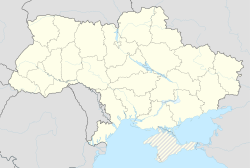Kozova
|
Kozova Козова |
|||
|---|---|---|---|
|
|||
| Location of Kozova, Ukraine | |||
| Coordinates: 49°25′55″N 25°09′34″E / 49.43194°N 25.15944°E | |||
|
Country Oblast Raion |
Ukraine Ternopil Oblast Kozova |
||
| Area | |||
| • Total | 18 km2 (7 sq mi) | ||
| Population (2006) | |||
| • Total | 8,900 | ||
| • Density | 509/km2 (1,320/sq mi) | ||
| Postal code | 47600 | ||
| Area code(s) | +380 3547 | ||
| Climate | Dfb | ||
| Website | http://www.koz.org.ua | ||
Kozova (Ukrainian: Козова; Polish: Kozowa; Russian: Козо́ва) is an urban-type settlement in the Ternopil Oblast (province) of western Ukraine, in the area historically known as Galicia, 16 km (10 mi) east of Berezhany, some 30 km (19 mi) west of Ternopil and c. 100 km (62 mi) southeast of Lviv. The town is situated beside a lake on the Koropets River (“little carp”). There is presumption that the name Kozova comes from the Ukrainian word koza (goat), though other possible sources exist.
During 1350-1772 and again in 1919-1939 it was part of Poland. The first partition of Poland in 1772 attributed Galicia to the Habsburg Monarchy. See more details in the article Kingdom of Galicia and Lodomeria. The Polish name Kozowa was used until 1939.
Kozova was part of the Soviet Union in the years 1939-1991, interrupted by the period of German occupation in 1941-1944.
The population in 1939 was about 5,000, including many Poles and Jews. Upon the German occupation following Operation Barbarossa, the extermination of the town's Jewish population began. About 1.000 Jews were deported from Kozova to the Belzec death camp on 21 September 1942. In April 1943, another 1,000 Kozova Jews were shot by Germans, and in June 1943, 400 more Jews were executed by the Nazis. All are buried in mass grave in Kozova. After the war's end, the remaining population is exclusively Ukrainian, with only a few Poles, Jews and Russians.
...
Wikipedia



